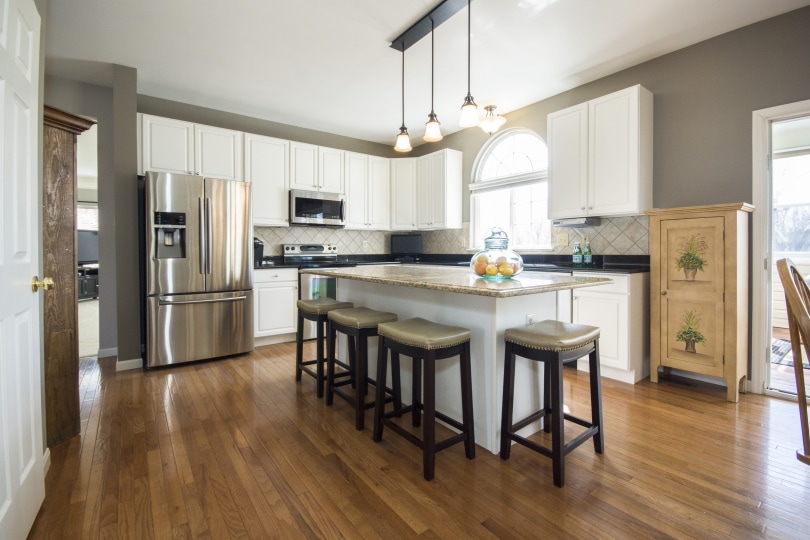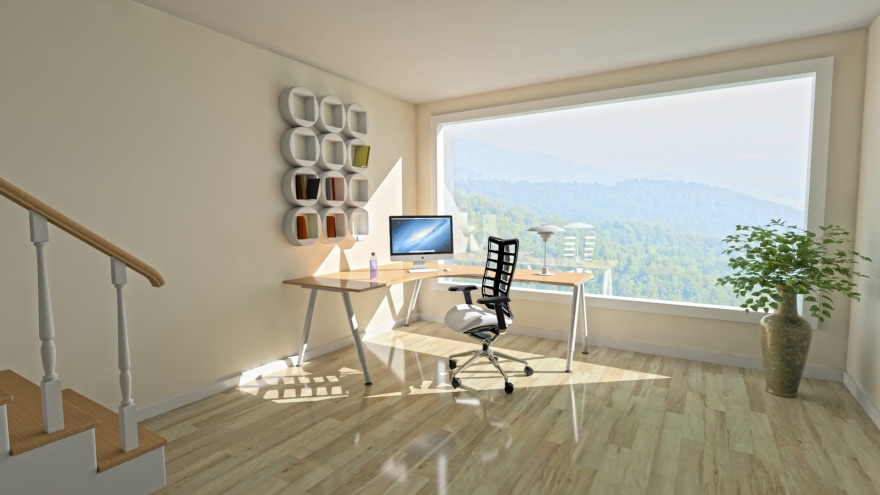7 Different Types of Wood Flooring Patterns (with Pictures)
-
Pete Ortiz
- Last updated:

There are many different types of wood flooring patterns that can be installed in any home. Unique patterns can change the entire look and feel of a room. Some patterns are ancient in their design, while others are more contemporary. Each pattern comes with its own set of benefits and drawbacks depending on skill level and individual style. Next time you find yourself standing on an unfamiliar wood floor, look down, and you are sure to see one of these patterns staring back at you.
Here are seven different types of wood flooring patterns for you to consider.
The 7 Different Types of Wood Flooring Patterns
1. Herringbone
| Style: | Classic |
| Skill level: | Advanced |
While herringbone is certainly in style right now, it is not trendy or new. Herringbone has been around for a long time. This pattern is defined by a series of perpendicular rectangles that can be installed either parallel to the room’s boundary or at a 45-degree angle. The angled herringbone pattern is what is currently in style. Herringbone is a classic look that fits almost any type of room, from kitchens to bedrooms.
However, installing herringbone is not simple. It takes a lot of cutting and a lot of preplanning. Installing herringbone wrong can lead to a lot of waste or a room that doesn’t look quite right.
The name is derived from the finished appearance. The design looks a lot like the bones of a skinned fish which tells you how old this pattern is. When was the last time you saw a fish that had been picked clean to the bones?
- Classic look
- Currently in style
- Hard to install
2. Brick
| Style: | Rustic |
| Skill level: | Beginner |
Brick wood floor patterns utilize uniform length boards to create the appearance of traditional brick floors. This pattern is simple to install because the uniformity of the length means very little cutting. The pattern requires each board to be installed offset one half a length from the surrounding planks – just like a brick floor would be.
This style is rustic and brings the classic look of old brick floors into the modern home with whatever kind of wood floor you want. Many designers like the clean, organized look of brick pattern floors.
- Uniform length boards
- Little cutting
- Little waste
- Rustic style won’t appeal to everyone
3. Chevron
| Style: | Classic |
| Skill level: | Advanced |
Chevron is very similar to herringbone with a few key differences. Chevron is an inverted V pattern that creates a seamless zigzag that can cross entire rooms uninterrupted. The difference between herringbone and chevron is the angle at which the boards are cut and placed. Chevron is done at a smaller angle, while herringbone is installed at perpendicular right angles. Chevron’s lower angle makes more of a point which gives it that inverted “V” look.
Chevron is very popular right now, and it is being utilized as a pattern for floors and backsplashes alike. However, due to the precise angles needed, it takes an advanced skill level to install properly and often comes with a lot of waste.
Like herringbone, chevron is also ancient. Chevron patterns have been discovered in designs dating back to Ancient Greece.
- Stylish
- Can create uninterrupted patterns
- Advanced installation
- Waste
Find a flooring specialist in your area, and get free, no-commitment estimates for your project.Consult a flooring expert

4. Basketweave
| Style: | Rustic |
| Skill level: | Intermediate |
Basketweave is another style of wood floor that is common. Basketweave is defined by equal-sized squares made up of individual planks offset from one another. For example, one square will contain four planks running vertically, while the adjacent square will contain four planks running horizontally. This offset repeating pattern creates the appearance of an old weave when done properly.
Basketweave is relatively simple to install. The pre-planning and measurement stage is the more important part. The most difficult part is getting the precise measurements for a uniform look that fits the room. This pattern borders between beginner and intermediate skill levels to pull off. Once you have all the measurements down, it is as simple as cutting equal-length boards and alternating between horizontal and vertical.
- Eye-catching uniformity
- Little waste
- Tricky measurements and planning
5. 3D Parquet
| Style: | Traditional |
| Skill level: | Advanced |
3D parquet is an odd pattern that is most commonly found in old manors and 19th-century mansions than typical homes. Nevertheless, 3D parquet is an established flooring pattern that has been found all over the world. This pattern gets its name from the unique ability to create optical illusions on the floor. If done correctly, a 3D parquet floor can manifest cubes, diamonds, and vertical-looking stairways.
3D parquet is a highly traditional flooring that requires artisan skill levels to produce. Different shades, board lengths, and intensive planning are required to get the desired result. For those reasons, it is not a popular flooring style for a typical home and is not able to be set by average homeowners.
This pattern will be beloved by people looking for a traditional, Victorian or elegant design in certain homes.
- Unique look
- Complex designs
- Versatile
- Hard to install
- Expensive
- Eclectic style
6. Straight Run

| Style: | Classic |
| Skill level: | Beginner |
Straight run flooring is perhaps the easiest and most basic flooring pattern to install. It is the most common style of flooring and is found all over the world. Straight runs can be seen in houses built this year and houses built three hundred years ago. Straight run patterns can be installed either vertically or horizontally. The flooring can be installed with uniform length boards or variable length boards.
One of the reasons this flooring pattern is so popular is that it is easy to install with little skill required. The straight run has very little waste or calculations needed to accomplish. The only downside is that the classic look is often too basic for some people’s design tastes.
- Easy to install
- Little to no waste
- Classic look
- Basic
- Not unique
7. Diagonal
| Style: | Contemporary |
| Skill level: | Intermediate |
Diagonal flooring serves as a middle ground between more complicated patterns like herringbone and simple patterns like straight run. A good diagonal pattern can really increase the flow of a room and create a fetching contrast to nearby floors. Diagonal floors are more contemporary than some of their ancient counterparts as they are primarily used to break up transitions between floors and rooms in a way that the people of yore never did.
Diagonal floors carry an intermediate skill level because it requires some measuring and planning to pull off effectively. The shortening of the board lengths along the edges of the room can lead to some waste, especially if the planning phase does not shake out as efficiently as possible. Still, diagonal floors are a great way to create contrast and flow in various spaces throughout a house.
- Great for contrast
- Clean look
- Lots of waste
- Tricky planning
Are There Other Patterns To Consider Outside of This List?
Yes. There are dozens of potential patterns that can be created with wood flooring. The seven patterns featured here are the most common and most recognizable. Other patterns include inlaid floors that incorporate stone or marble into their design. Random patterns are also popular right now, where boards of varying lengths are put down at random, and the remaining boards are cut to fill the gaps. Random patterns are cropping up in rustic houses looking to emulate barn wood and reclaimed wood looks.

What Is The Best Way To Choose a Wood Pattern?
Choosing a wood floor pattern will be entirely up to the homeowner but there are some factors to consider. First, choose a style for your room. Some of these patterns are classic, while others are more contemporary. Also, examine the patterns in the surrounding rooms and pick a pattern that will either compliment, mesh or contrast with the nearby floor patterns.
Another thing to consider is the price. Not all flooring patterns cost the same to install, and for some designs, the cost will absolutely be a factor.
Do Some Patterns Cost More To Install Than Others?
Yes. Some patterns are more expensive than others. The most complex patterns can cost as much as two or three times more than simple patterns. The cost of a pattern’s installation comes from the time it takes to install, and the waste and those two things go hand in hand. The more complicated the design, the longer it takes to get right. The more cutting a pattern requires, the more waste it will generate. Patterns with high amounts of waste require much more materials than patterns with little waste which drives up the cost.
Conclusion
Flooring patterns are easy to overlook, but once you start noticing them, they become much more visible. A flooring pattern can completely change the look of a room or can be used to break up a space or an entire floor plan. There are seven distinct and easily recognizable wood flooring patterns that recur over and over again in design. The only question now is, which pattern is right for you?
Related Reads:
- 10 Dining Room Flooring Trends – Design Ideas For A Modern Home
- 15 Hardwood Floor Trends – Design Ideas for a Modern Home
- Cost to Install Hardwood Floors (Cost Per Square Foot)
Featured Image Credit: Piqsels
Contents



